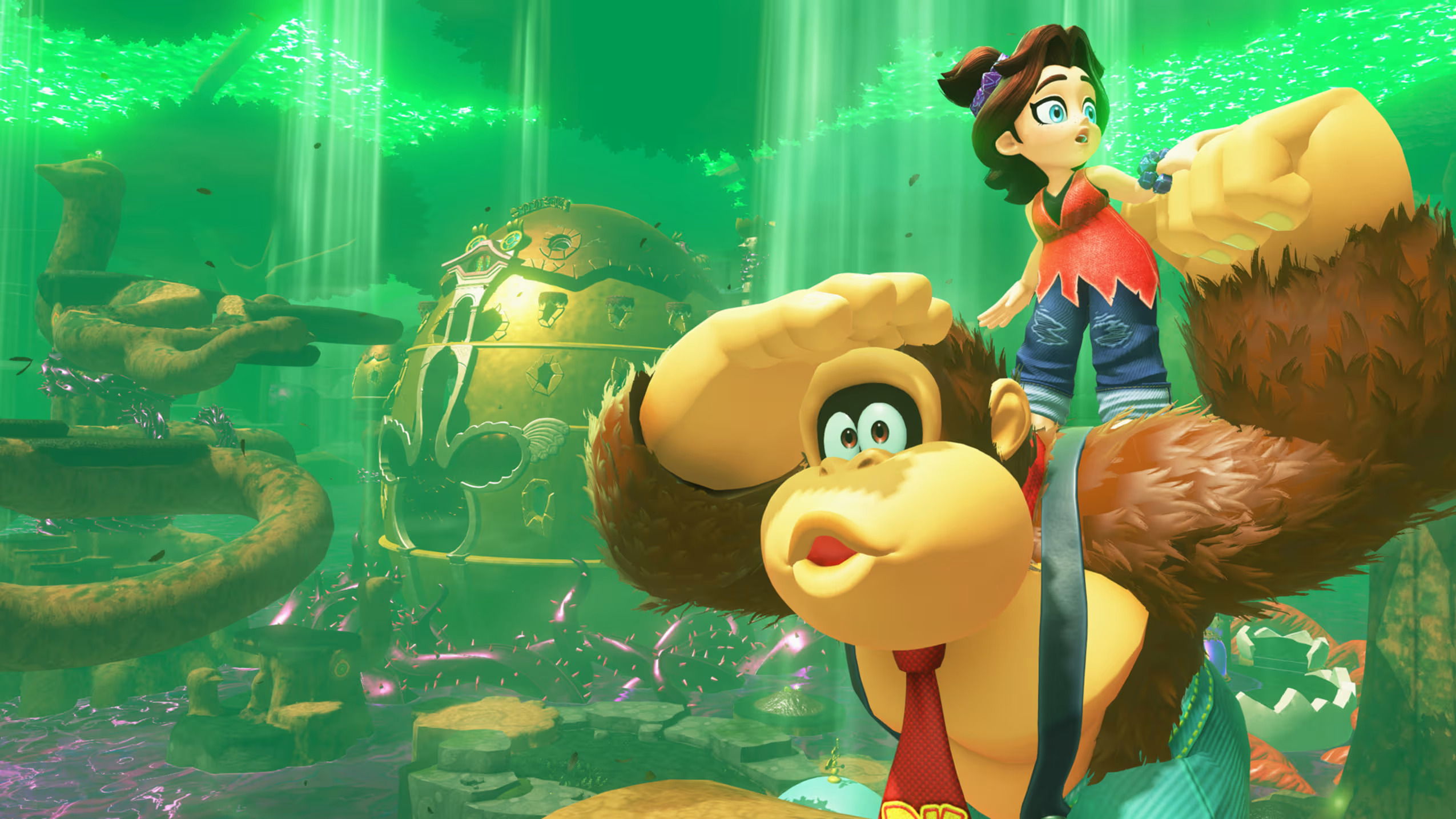By Donovan Erskine
Last week, I attended a preview event for Donkey Kong Bananza in New York City. I spent a couple of hours with the upcoming 3D platformer to see just how Nintendo is handling Donkey Kong’s long-awaited return to the spotlight.
As revealed in its dedicated Nintendo Direct, Donkey Kong Bananza follows the iconic character as he embarks on a journey alongside a young Pauline to reach the planet’s core, where they are rumored to receive one wish. With Pauline hoping to make it back home to the surface and pursue her singing career and DK in pursuit of more bananas, the duo will need each other to accomplish their goals. During my demo, I jumped around to a few different sections of the game.
First up, I played through Donkey Kong Bananza’s opening, which sets the stage for this subterranean adventure. Each layer of the world essentially serves as a level or stage. You roam an open zone where you can grab collectibles, fight enemies, and eventually find a pathway to the next layer. While you could certainly mainline the story and sprint to the primary objectives upon reaching a new layer, I found it impossible to resist the various distractions each new area presented.
Donkey Kong Bananza features destructible environments, as DK can use his fists to blast the terrain around him. You’re rewarded for this, as chests, gold, and collectibles are often hidden beneath the surface. Donkey Kong’s sonar ability can help identify nearby collectibles, and some chests hold treasure maps that will pinpoint buried goods on your 3D map.
I was shocked by just how in-depth the destructible environment system goes. There are multiple terrain types, such as dirt, sand, stone, concrete, and obsidian. They have different hardness values, which determines how difficult it is for DK to pound through them. These materials can also be grabbed in chunks and used as projectiles, melee weapons, surfboards, and springboards for double-jumping. Some of them even have unique properties. For example, obsidian explodes upon impact, making it perfect for destroying any concrete that’s blocking your path to some good loot.
You could easily spend hours destroying all of the terrain a level has to offer, and I had to stop myself from spending my entire demo just digging around and making tunnels so that I could actually see all of the available content. There’s a cathartic feeling in just swinging DK’s fist around, creating a path of destruction as you endlessly harvest materials.
Donkey Kong Bananza was developed by the Super Mario Odyssey team, and it shows. Banandium Gems are large banana-shaped crystals and serve as this game’s primary collectible. Similar to Mario Odyssey’s Moons, Banandium Gems are littered throughout the world and are found through exploration, obtained by completing environmental puzzles, and given as a reward from Challenge Course Ruins. Each Banandium Gem has a name corresponding to the method of which it’s obtained, and DK strikes a pose every time you collect one.
Collecting Banandium Gems earns you Skill Points, which can be used to unlock new abilities for Donkey Kong or improve the effectiveness of his existing ones. Early on, I prioritized increasing my health (you begin with three hearts) and the strength of my punches. Skill Points can also be spent to improve DK’s sonar ability, or to further empower his Bananza forms. The base version of his Ostrich Bananza can only fly for a short period of time, so I made sure to upgrade that when I had enough Skill Points. Some abilities only cost one Skill Point to upgrade, with later upgrades costing multiple.
Before I got to play the game, a Nintendo Treehouse employee told us that Donkey Kong Bananza isn’t a DK game featuring Pauline; the characters share the story as co-protagonists. They both drive the narrative forward, and this came through in both the story and gameplay. Pauline is a vocal companion, often making remarks when you spot a collectible or fight enemies.
Pauline becomes more important when playing in co-op, which I also got to do a bit of. While playing as Pauline, she can shout onomatopoeia that turn into projectiles. These large projectiles can impact the environment and deal damage to enemies. Using the Joy-Con 2’s mouse feature (or analog stick), you can aim at different materials and absorb them.
Using Pauline in co-op is actually pretty powerful—dare I say OP. Her projectiles give her a proficiency at range that DK doesn’t have, and if you get her some gold or obsidian, she can unleash absolute chaos. During a boss battle, I was able to do a majority of the damage without DK even having to get close, although I’m sure the demoist I was playing with intentionally let me do a lot of the heavy lifting.
During my limited time with Donkey Kong Bananza, I could already picture how I’ll be playing the game when I have it at home. I’ll be taking my time to pick apart every level, mowing through the destructible environments while snapping up every Banandium Gem and piece of gold I can get my hands on. I’ll find a cool matching outfit for DK and Pauline, and I’ll probably prioritize making his Bananza forms as powerful as possible early on.
It’s because of this that I already know Nintendo has a rich 3D platformer on its hands. There’s so much to dig (pun intended) into, and it still feels like the game is holding some surprises for launch. As the first major game following the launch of the Switch 2, it’s fair to say that there’s a decent amount of expectations riding on this one.
This preview is based on an early build of Donkey Kong Bananza played at a press event. Donkey Kong Bananza launches for the Nintendo Switch 2 on July 17, 2025.
